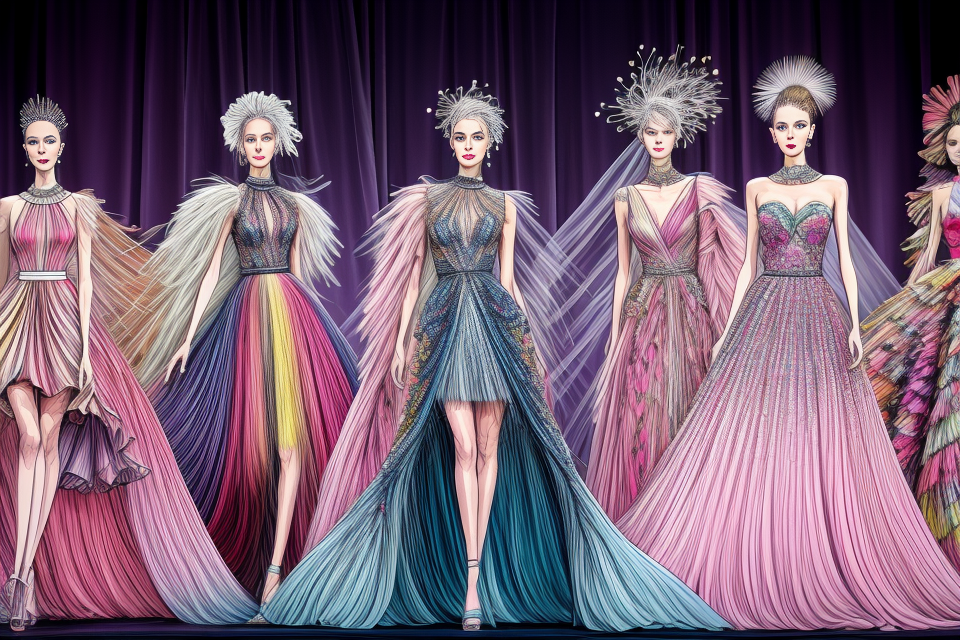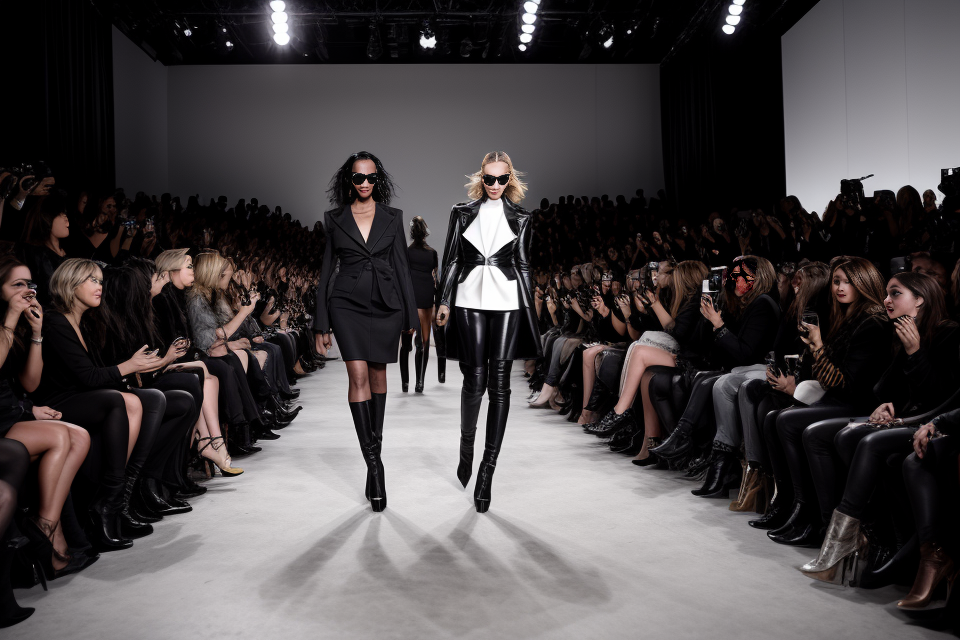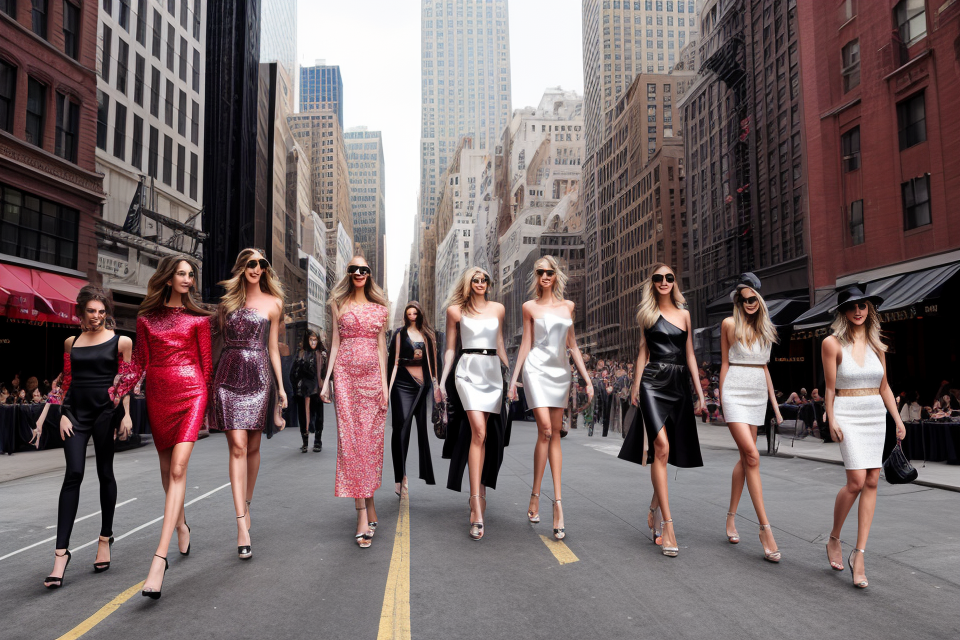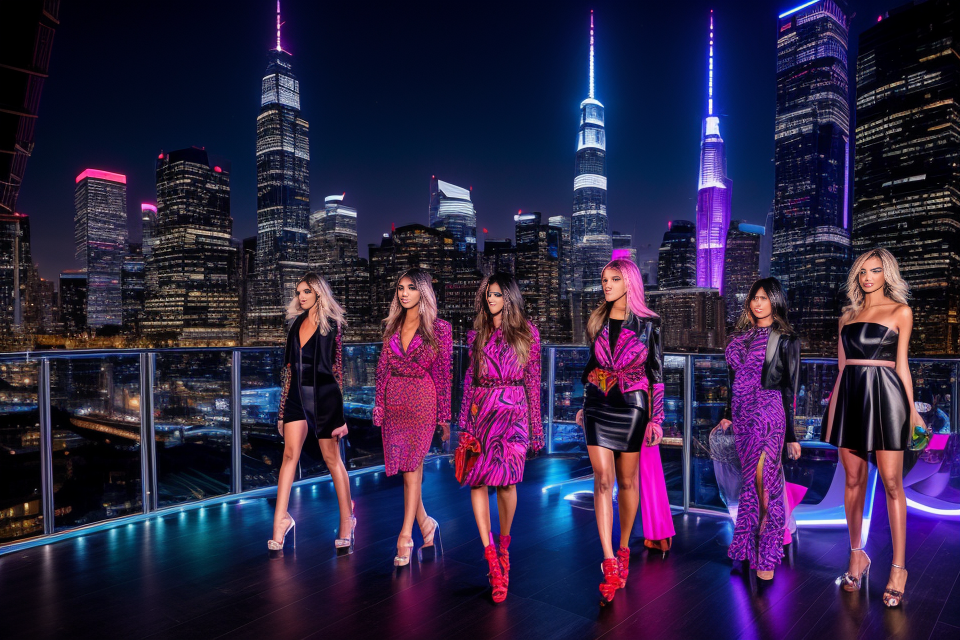
Fashion shows are a staple of the fashion industry, and there are several types of fashion shows that cater to different audiences and purposes. From runway shows to charity events, each type of fashion show has its own unique style and atmosphere. In this article, we will explore the different types of fashion shows and what makes them unique. Get ready to discover the exciting world of fashion shows!
Fashion shows come in various forms, each serving a specific purpose in the fashion industry. The most common type is the runway show, where models walk down a catwalk wearing the latest designs from fashion designers. These shows are often held during fashion weeks in cities like New York, Paris, and Milan, and are attended by industry professionals, buyers, and media. Another type of fashion show is the trunk show, which is a smaller, more intimate event where designers showcase their latest collections to a select group of clients. Additionally, there are charity fashion shows, which raise money for a particular cause, and trade shows, which are events where designers and manufacturers showcase their latest products to buyers and retailers. Finally, there are couture shows, which are held in Paris and feature high-end, custom-made designs. Each type of fashion show serves a different purpose and offers a unique experience for those involved in the fashion industry.
Overview of Fashion Shows
Definition of Fashion Shows
Fashion shows are events that serve as a platform to showcase new fashion designs and trends. They are organized by fashion designers, brands, and fashion houses to present their latest collections to buyers, retailers, media, and the public. The purpose of fashion shows is multifaceted and includes marketing, inspiration, and communication.
Marketing is a key aspect of fashion shows, as they provide an opportunity for designers and brands to promote their products and gain exposure. Fashion shows allow designers to showcase their latest collections to industry professionals, buyers, and the media, which can help generate interest and sales.
Inspiration is another important aspect of fashion shows. They provide a platform for designers to showcase their creativity and vision, and to inspire others in the fashion industry. Fashion shows often feature unique and innovative designs, which can spark new trends and inspire future collections.
Communication is also an important aspect of fashion shows. They provide a platform for designers and brands to communicate with their target audience, and to build relationships with industry professionals and the media. Fashion shows can help designers and brands establish their identity and build their reputation in the fashion industry.
Overall, fashion shows play a crucial role in the fashion industry, serving as a platform for designers and brands to showcase their latest collections, generate interest and sales, inspire others, and communicate with their target audience.
History of Fashion Shows
Fashion shows have a rich and fascinating history that dates back to the late 19th century. The origins of fashion shows can be traced back to the private salon shows that were held by French and American designers. These shows were intimate events that were attended only by the elite of society, and they were designed to showcase the latest fashion trends.
As the fashion industry grew and became more commercialized, fashion shows began to evolve from private salon shows to public events. The first public fashion show was held in Paris in 1903, and it was organized by the French fashion designer, Paul Poiret. This event marked the beginning of the modern era of fashion shows, and it set the stage for the growth and development of the industry in the years that followed.
The impact of fashion shows on the fashion industry and popular culture cannot be overstated. These events have played a crucial role in shaping the way that people think about fashion, and they have helped to establish the designers and brands that have become synonymous with the industry. Fashion shows have also played a significant role in the development of popular culture, and they have inspired countless artists, designers, and fashion enthusiasts around the world.
Despite the many changes that have occurred in the fashion industry over the years, fashion shows remain an essential part of the landscape. They continue to be a vital platform for designers to showcase their latest collections, and they continue to inspire and captivate audiences around the world.
Types of Fashion Shows
Runway Shows
Overview of Runway Shows
A runway show is a fashion event where models display clothing and accessories designed by fashion designers. These shows are held to showcase the latest fashion trends and styles to the public, buyers, and the media. Runway shows are a crucial part of the fashion industry as they provide a platform for designers to showcase their work and gain exposure.
Types of Runway Shows
There are several types of runway shows, each with its unique characteristics and purpose.
Traditional Runway Shows
Traditional runway shows are the most common type of fashion show. They typically take place on a runway, which is a long, narrow stage with seating for the audience. The models walk down the runway, stopping at the end to strike a pose. Traditional runway shows are often held to showcase a designer’s collection for a particular season or fashion week.
Couture Runway Shows
Couture runway shows are more formal and typically take place during Paris Fashion Week. These shows are attended by VIPs, celebrities, and high-end buyers. The designs presented at couture shows are usually one-of-a-kind and are made from high-quality materials. The models who walk in couture shows are often the most famous and successful models in the industry.
Presentation Runway Shows
Presentation runway shows are less formal than traditional runway shows. They often take place in a showroom or other venue where the clothes are displayed on mannequins or models standing in place. Designers may choose to present their collections in this way if they do not have the resources to put on a traditional runway show.
Flash Runway Shows
Flash runway shows are short, fast-paced shows that take place in a small space. They are often used to showcase new designs or collections in a quick and efficient way. Flash runway shows are becoming increasingly popular as they allow designers to showcase their work without the need for a large venue or a long production process.
Differences between Runway Show Types
Each type of runway show has its unique characteristics and purpose. Traditional runway shows are the most common and are often used to showcase a designer’s collection for a particular season or fashion week. Couture runway shows are more formal and are attended by VIPs and high-end buyers. Presentation runway shows are less formal and are often used to showcase new designs or collections in a quick and efficient way. Flash runway shows are short, fast-paced shows that take place in a small space. Understanding the differences between these types of runway shows can help designers choose the best way to showcase their work and gain exposure.
Presentation Shows
Presentation shows are a type of fashion show that differ from traditional runway shows in that they are less formal and often more intimate. These shows are designed to give designers a platform to showcase their work in a more personal and creative way.
Overview of Presentation Shows
Presentation shows are often smaller in scale than traditional runway shows and can take place in a variety of venues, including small clubs, boutiques, and even online platforms. These shows often feature a smaller selection of designs and are more focused on the creative vision of the designer.
Purpose of Presentation Shows
The purpose of presentation shows is to give designers an opportunity to showcase their work in a more personal and creative way. These shows often focus on a specific theme or concept and allow designers to express their unique vision and style.
Types of Presentation Shows
There are several types of presentation shows, including:
Small-scale Presentation Shows
Small-scale presentation shows are typically held in intimate venues and feature a small selection of designs. These shows often focus on a specific theme or concept and are designed to give designers a platform to showcase their work in a more personal and creative way.
Pop-up Presentation Shows
Pop-up presentation shows are a type of presentation show that are held in temporary venues, such as pop-up shops or art galleries. These shows often feature a smaller selection of designs and are designed to create a unique and immersive experience for attendees.
Online Presentation Shows
Online presentation shows are a type of presentation show that are held on online platforms, such as social media or e-commerce websites. These shows often feature a smaller selection of designs and are designed to give designers a platform to showcase their work to a wider audience.
Differences between Presentation Shows and Runway Shows
The main difference between presentation shows and runway shows is the level of formality and the scale of the event. Presentation shows are often smaller and more intimate, while runway shows are larger and more formal. Additionally, presentation shows often focus on a specific theme or concept, while runway shows typically showcase a designer’s entire collection.
Trade Shows
Trade shows are a type of fashion show that are designed to showcase the latest trends and products in the fashion industry. These shows are typically attended by industry professionals, such as buyers, retailers, and manufacturers, and are used as a platform for business meetings and networking.
Fashion Trade Shows
Fashion trade shows are a subcategory of trade shows that are specifically focused on showcasing the latest fashion trends and products. These shows often feature runway shows, product demonstrations, and exhibitor booths where companies can showcase their latest collections and products.
Accessory Trade Shows
Accessory trade shows are another subcategory of trade shows that are focused on showcasing the latest accessories in the fashion industry, such as jewelry, handbags, and shoes. These shows often feature exhibitor booths where companies can showcase their latest accessory collections and products.
Textile Trade Shows
Textile trade shows are a subcategory of trade shows that are focused on showcasing the latest textiles and fabrics in the fashion industry. These shows often feature exhibitor booths where companies can showcase their latest textile and fabric collections and products.
Differences between Trade Shows and Other Types of Fashion Shows
Trade shows differ from other types of fashion shows, such as runway shows and charity shows, in that they are focused on business and networking rather than entertainment or philanthropy. Trade shows also tend to be more exclusive and invitation-only, with a focus on industry professionals rather than the general public.
Charity Fashion Shows
Charity fashion shows are a unique type of fashion event that combines the world of fashion with philanthropy. These events are designed to raise money and awareness for various charitable causes.
Overview of Charity Fashion Shows
Charity fashion shows typically feature a runway show where models display the latest fashion trends, as well as a silent auction of designer items and other luxury goods. These events often take place in exclusive venues and are attended by celebrities, fashion industry professionals, and philanthropists.
Purpose of Charity Fashion Shows
The primary purpose of charity fashion shows is to raise funds for charitable causes. These events can also raise awareness about specific issues and bring attention to the work of the charitable organizations involved.
Types of Charity Fashion Shows
There are several types of charity fashion shows, including:
Runway Charity Fashion Shows
Runway charity fashion shows are the most traditional type of charity fashion event. These events feature a runway show where models wear the latest fashion trends, and the audience can bid on items displayed on the runway or in a silent auction.
Pop-up Charity Fashion Shows
Pop-up charity fashion shows are temporary events that are held in unexpected locations, such as vacant storefronts or pop-up shops. These events are often organized quickly and are designed to create a sense of urgency and excitement around the charitable cause.
Online Charity Fashion Shows
Online charity fashion shows are events that take place on social media platforms or other online channels. These events often feature a live stream of the runway show, as well as a silent auction of designer items and other luxury goods.
Differences between Charity Fashion Shows and Other Types of Fashion Shows
Charity fashion shows differ from other types of fashion shows in that they have a specific charitable purpose. These events often have a more exclusive and high-end feel, with attendees who are interested in both fashion and philanthropy. Additionally, charity fashion shows may feature a wider range of items available for bid, including luxury goods and experiences, in addition to clothing and accessories.
Celebrity Fashion Shows
Celebrity fashion shows are a type of fashion show that feature famous individuals as models. These shows are designed to generate excitement and interest in the latest fashion trends, and often feature high-end designers and luxury brands.
Overview of Celebrity Fashion Shows
Celebrity fashion shows are typically held at high-profile events such as award shows, film festivals, and charity galas. They often take place on a runway or stage, and may feature live music, lighting, and other special effects to create a dramatic atmosphere.
Purpose of Celebrity Fashion Shows
The primary purpose of celebrity fashion shows is to promote the latest fashion trends and showcase new designs. They are often used as a marketing tool by designers and brands to generate buzz and excitement around their products. In addition, celebrity fashion shows can be a source of inspiration for consumers, providing ideas and inspiration for their own personal style.
Types of Celebrity Fashion Shows
There are several types of celebrity fashion shows, including:
- Red Carpet Events: These are formal events where celebrities are dressed in their finest attire and walk down a red carpet. They are often televised and can be viewed by millions of people around the world.
- Fashion Awards Shows: These are events where awards are given out to recognize achievements in the fashion industry. Celebrities attend these events and often wear designer gowns and suits on the red carpet.
- Collaborations with Designers: Some designers collaborate with celebrities to create unique fashion pieces that are showcased in fashion shows. These collaborations can generate a lot of buzz and attention for both the designer and the celebrity involved.
Differences between Celebrity Fashion Shows and Other Types of Fashion Shows
While celebrity fashion shows are a popular type of fashion show, they differ from other types of fashion shows in several ways. Unlike traditional fashion shows, which focus on the clothing and designs themselves, celebrity fashion shows are often more about the celebrity and their personal style. In addition, celebrity fashion shows are often more high-profile and televised, which can generate a lot of media attention and publicity for the designer and celebrity involved.
Virtual Fashion Shows
Virtual fashion shows have become increasingly popular in recent years due to the COVID-19 pandemic. They are events that take place online, allowing designers to showcase their collections to a global audience without the need for physical space or travel.
Overview of Virtual Fashion Shows
Virtual fashion shows can take various forms, from live-streamed events to pre-recorded videos or even augmented reality experiences. These shows are often interactive, with designers using technology to create immersive experiences for viewers.
Purpose of Virtual Fashion Shows
The purpose of virtual fashion shows is to showcase new collections to buyers, media, and consumers. They provide an opportunity for designers to connect with their audience and build their brand, even in times of physical distancing.
Types of Virtual Fashion Shows
There are several types of virtual fashion shows, each with its own unique features and benefits.
Live-streamed Fashion Shows
Live-streamed fashion shows are events that are broadcasted in real-time over the internet. They allow designers to connect with their audience in real-time, answering questions and interacting with viewers during the show.
Pre-recorded Fashion Shows
Pre-recorded fashion shows are events that are filmed in advance and then made available online. They provide designers with more creative control over the presentation of their collections, as they can edit and enhance the footage to create a more polished final product.
Augmented Reality Fashion Shows
Augmented reality fashion shows use technology to create immersive experiences for viewers. They allow designers to create virtual runways and environments, giving viewers a unique perspective on their collections.
Differences between Virtual Fashion Shows and Other Types of Fashion Shows
Virtual fashion shows differ from traditional fashion shows in several ways. They are more accessible, as they can be viewed from anywhere with an internet connection. They are also more environmentally friendly, as they reduce the need for travel and physical space. Additionally, virtual fashion shows can be more cost-effective for designers, as they do not require the same level of production and logistics as traditional fashion shows.
FAQs
1. What are the different types of fashion shows?
There are several types of fashion shows, including runway shows, charity shows, trade shows, and fashion weeks.
2. What is a runway show?
A runway show is a type of fashion show where models walk down a runway and showcase clothing and accessories from designers or fashion houses. These shows are often held during fashion weeks and are attended by industry professionals, buyers, and media.
3. What is a charity show?
A charity show is a type of fashion show that is held to raise money for a particular cause or charity. These shows often feature celebrities and high-profile designers and are usually attended by wealthy donors and philanthropists.
4. What is a trade show?
A trade show is a type of fashion show that is held for trade professionals, such as buyers, retailers, and manufacturers. These shows often feature new and upcoming designers and are a way for industry professionals to discover new trends and make business connections.
5. What is a fashion week?
A fashion week is a week-long event that is held in major cities around the world, such as New York, London, Paris, and Milan. During fashion week, designers and fashion houses showcase their latest collections to industry professionals, buyers, and media. These shows are often high-profile events that attract a lot of attention from the fashion world.


